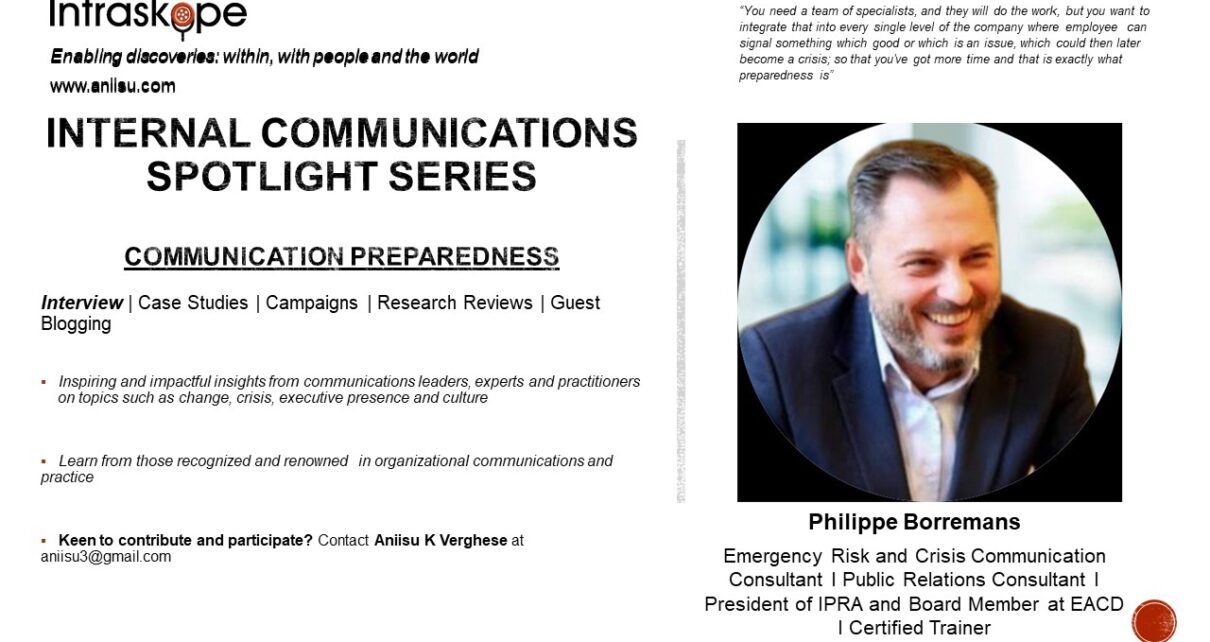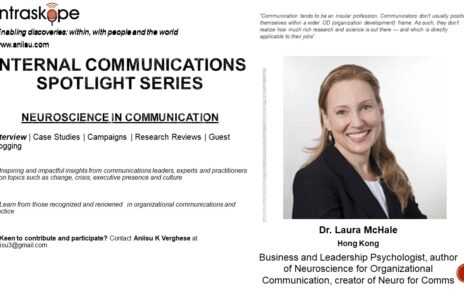Welcome to the 15th edition of Intraskope’s Spotlight Series featuring Philippe Borremans, an Emergency Risk and Crisis Communication Consultant. He is also a public relations consultant and a certified trainer. Philippe serves as the President of IPRA and is a Board Member at EACD.
About Intraskope’s Spotlight Series
In this series I interview key thought leaders on topics interrelated with internal communications such as culture, crisis, change, executive presence and leadership. The goal is to help unravel why they matter, what can leaders and communicators learn from experts and how we can put insights to practice. Watch these short interviews and get better at understanding these key topics and how you engage with internal communications.
In this episode with Philippe, we discuss a topic which isn’t often on top of every organization’s consciousness unless they face a crisis. Rather than fire fighting when the situation goes out of hand, it is best to be prepared; and that takes a strategic approach to planning, monitoring, training, reporting and engaging.
As an independent multi-lingual corporate communications professional with over 20 years’ experience, Philippe brings a wealth of knowledge in both internal and external communications, crisis communications, online reputation management, media training and media relations. In 2016 Philippe moved to Morocco and was appointed Strategic Director at PR Media, a leading PR agency in the Maghreb region and is based in Casablanca, Morocco. Today he is an independent public relations consultant specializing in Crisis & Emergency Risk Communications and works with clients across the globe, based in Portugal.
“You want to integrate preparedness into every single level of the company where employee can signal something which good or which is an issue, which could then later become a crisis; so that you’ve got more time and that is exactly what preparedness is”, says Philippe.
Interview
- You have worked extensively with risk, emergency and crisis communications. What, according to you is the definition of communication preparedness?
Well, it’s a very large topic but I think we don’t discuss that enough. We talk a lot about crisis communications about risk communication, but it’s a bit, if you look at it from a private sector I’ve worked in the private sector for many years for multinationals like IBM, where I was responsible for the public relations for instance, preparedness, from a communications point of view as well, is exactly the same thing as you would approach health, or security or other topics like that, and that is what preparedness is you prepare in what we call peacetime, and what the ultimate goal is, is that you would integrate that into a company culture. So crisis preparedness for instance from a communications point of view, is something that you do not want a small team to be responsible for, they will you need a team of specialists and they will do the work, but you want to integrate that into every single level of the company where employee can signal something which good or which is an issue, which could then later become a crisis; so that you’ve got more time and that is exactly what preparedness is. Of course, if you look at it from another point of view in the context of epidemics or pandemics, that is national or country level preparedness, but the principle is exactly the same.
2. How much time do you think communicators must invest in getting and staying prepared? And how different is this from communication planning?
Well, it’s more like you would integrate that into, again we’re talking about the perfect world, and I know the realities of working in a company and, but in a perfect world it would. It’s integrated into your planning. If today you are responsible for communications in a company, you would have a strategic communications plan, I would suppose which integrates internal communications. And if everything works fine in that internal communication as part of that plan, you would have identified communication channels and procedures for employees to report an issue for instance, which you then take up before it becomes a crisis, and before it goes to the crisis communications team etc. So, I think it’s an integrated approach. Of course, that is a perfect world, I know that in many companies the internal comms plan is separate from the external comms plan and then people don’t talk to each other and what have you. One thing that I often say to crisis communications or risk communication colleagues is that your very first communication we do in the context of a crisis or an emergency is internal, not the reactive statement for the media. So you better be good friends with your internal communications colleagues and they should be involved in the planning, when you do a risk analysis. I’m talking from crisis communications, risk analysis. Internal communication should be at the table. Right, I know that’s not really the reality in many cases.
3. What are the key aspects of communication preparedness?
First, it is important to have systems in place which allow you again to identify issues because issue management is something that you can trouble you can still solve, solve the problem. Once it becomes a crisis, then the level of control is less and then you get into a crisis mode which is a different dynamic. So making sure that you have channels identified that a feedback loop is in place, that anyone in the company can use these channels to report things, or just to, you know, if you’re worried about a certain approach to something or, and that could be anything right, it’s a bit like when you work in the, in the chemical sector for instance or the very heavy industrial sector you see these big signs we didn’t have any accidents for, you know so many days, particularly same principle if you don’t work in those industries. Because those people anyone there can report a dangerous setting or a dangerous product which hasn’t been, you know, set away in a secure way, but it’s the same for every single industry, even in services companies. So that is one part that you at least have the channels in place in the procedure. And then it’s also ongoing training. Again, that but it’s going from lunch and learn sessions about the general topic of communication preventers or crisis preparedness, all the way down to doing simulation exercise on a regular basis reviewing the plans and things like that. But what I often see happening is that it is a responsibility of a crisis communication team if there is already a crisis communication team. It is a responsibility of the communications department, or public relations departments. But, but it’s, it needs to trickle down. You need to involve, all the rest as well because it’s a common understanding of what crisis or issues are. So that night we can get involved. Because we often forget you need your employees.
4. What signs tell you that communication preparedness is lacking?
You could see it in, in some small details, all the way down to when you what I do from time to time in the private sector, all these audits, redo plans, and test them, but already when you come, physically when you come into a company, and I do look at those things that professional. How, how easy to get into that company. What are the security procedures, how, how well is, is the signage, the visual welcoming the visual warning? How easy is it to get meetings with the right people, but then in the correct context and it’s very small things. If this organization is in a specific industry which is crisis broke. Basic simply actions are the basic again procedures in place. And then when you go up and up and up and when you can really do an audit, look at historical history. How is, how have previous issues, or crisis been handled, and learned from those, and then do a deep dive into plans and you see why I really want to see like, okay, so how many times do you do a crisis exercise once a year. So it depends on very, very different things but it goes from very small details right all the way on looking at okay, what’s the plan, how is it structured. Does he take into account different scenarios and things like that?
5. How can organizations get stronger with this aspect?
I think a lot of companies will have understood that now. I mean there are a couple of from a professional point of view, there are a couple of positives on this pandemic in the way that I think a lot of communicators have now seen the importance of internal communication I really see that happening around me, our internal comms colleagues. Finally, you know, are on that same level, I hope, but I’ve seen that in companies, and, and that is a good thing. I also think that there will be more interest in what we’re not just monitoring, like, companies do media and social media monitoring, but most of the time it’s what I call, a bit of a vanity monitoring – where does our brand stand. That’s nice to know. But that’s not why you do monitoring. You want to do predictive analysis – you want to see what’s coming, you want to see social movements happening you want to see what the competition is doing, you want to see what political entities have an impact. So, I think that aspect has become more important or at least some companies and communication prefer to start to think about this, and that’s where the interest is because if you do that very well. You see issues, and potential crisis arise that you have much more time to prepare and then prepare yourself and then act, whenever they are there, you know, we’ve often said, a lot of a lot of organizations have said, You would have a serious epidemic slash global pandemic in the risk analysis and how good, have we been prepared. If you observe every single Risk Report, national or international risk report over the last five years, and you will see in the top five potential risks epidemic going over into pandemic. It’s very well to do monitoring, but if you don’t use it to look a bit at the future, or potentially do scenario planning, then we’re not really being prepared for doing communication preparedness.
6. What advice do you have for communicators on preparing effectively?
I think the biggest lesson is what we’ve often forgotten, or we still do but out of habit, which is stakeholder identification mapping engagement or management. I think most communicators do that at the start of the year of the start of a plan and they, you know, play with the postings and then it’s done and then we you know it’s good, but it’s an ongoing activity. What you’ve now seen, I think, is that your if you would have had a good actively engaged stakeholder plan, things would have gone a bit better in the way that suddenly a company became responsible for the health of their employees. I mean, not from a health insurance point of view but from also communications point of view and you had to inform people about, you know, wearing a mask. And now we are getting, how do you get people back in the office. All these things, if, if, organizations, really look at stakeholder analysis mapping and engagement, then it’s much easier to, if something happens or arise, or comes up, you can involve your stakeholders from different aspects, government, NGOs, pressure groups, employees, so that it’s much more. You don’t have to start from zero, which I think a lot of companies have to do, because they were not really actively engaging with communities engaging with stakeholders.
Watch the complete video interview on YouTube or read the complete transcript above.
Missed the earlier episodes? Watch them here: D. Mark Schumann (Culture), Peter Yorke (Executive Presence), Sia Papageorgiou (Leadership Communications), Dianne Chase (Strategic Storytelling), Gloria Walker (Communication Planning), Rebecca Sangster-Kelly (Stakeholder Management), Ray Walsh (Localizing Employee Communications), Prof. Matt Tidwell (Reputation), Geri Rhoades (Manager Communications), Erik K Meyers (Business Acumen), Russell-Olivia Brooklands (IC Practice Governance), Paul Barton (Public Speaking and Business Communication), Cyrus Mavalwala (Digital Communication) and Elvera N Makki (Social Impact Communication).
You can also look up the ongoing Intraskope’s Spotlight on Internal Communication Series featuring practitioners from around the globe sharing best practices and perspectives.
Liked the interview? Post your comments and share it with your network.
Keen to participate in the ongoing series on Personal Branding, Crisis Communications, Internal Communications or CSR Communications? Drop me a note at [email protected]
Here are Internal Communications resources you can use:
- Learn: Internal Communications Fundamentals Course on Thinkific or Udemy
- Internal Communications Series: https://forms.gle/KcqmPzLwq7NQi5Km6
- Chat with Aniisu – Internal Communications: https://www.instamojo.com/intraskope/connect-with-aniisu-60-minute-personalized-d/?ref=store
- Internal Communications workshops: https://bit.ly/2zdBRl1
You can also visit my website www.intraskope.com and You Tube channel to know more about my work.
#IC #riskcommunication #mediamonitoring #emergencycommunication #stakeholdermapping #stakeholdermanagement #strategicthinking #communicationplanning #communicationpreparedness #reputation #commsriskprofile #crisismanagement #securecommunication #drive #credibilty #internalcomms #communications #internalcommunications # #covid19 #PhilippeBorremans



